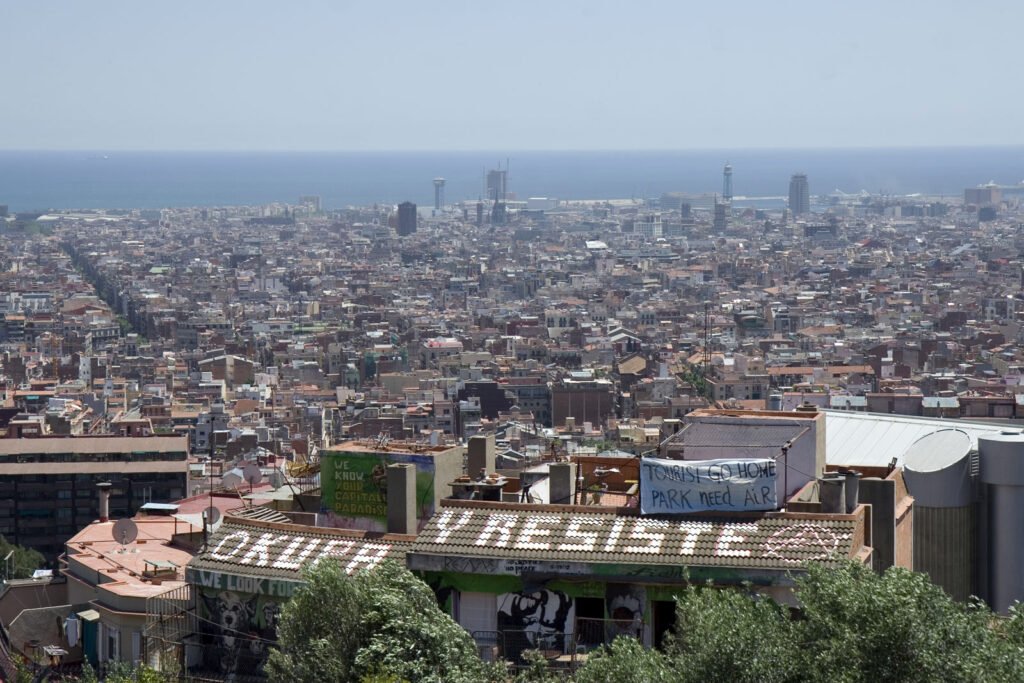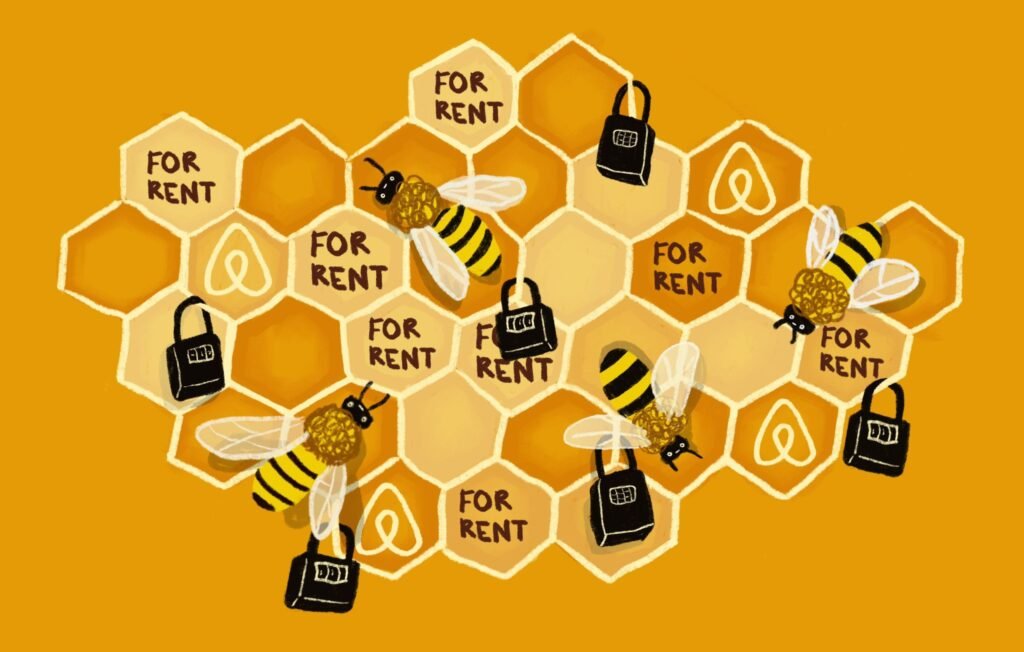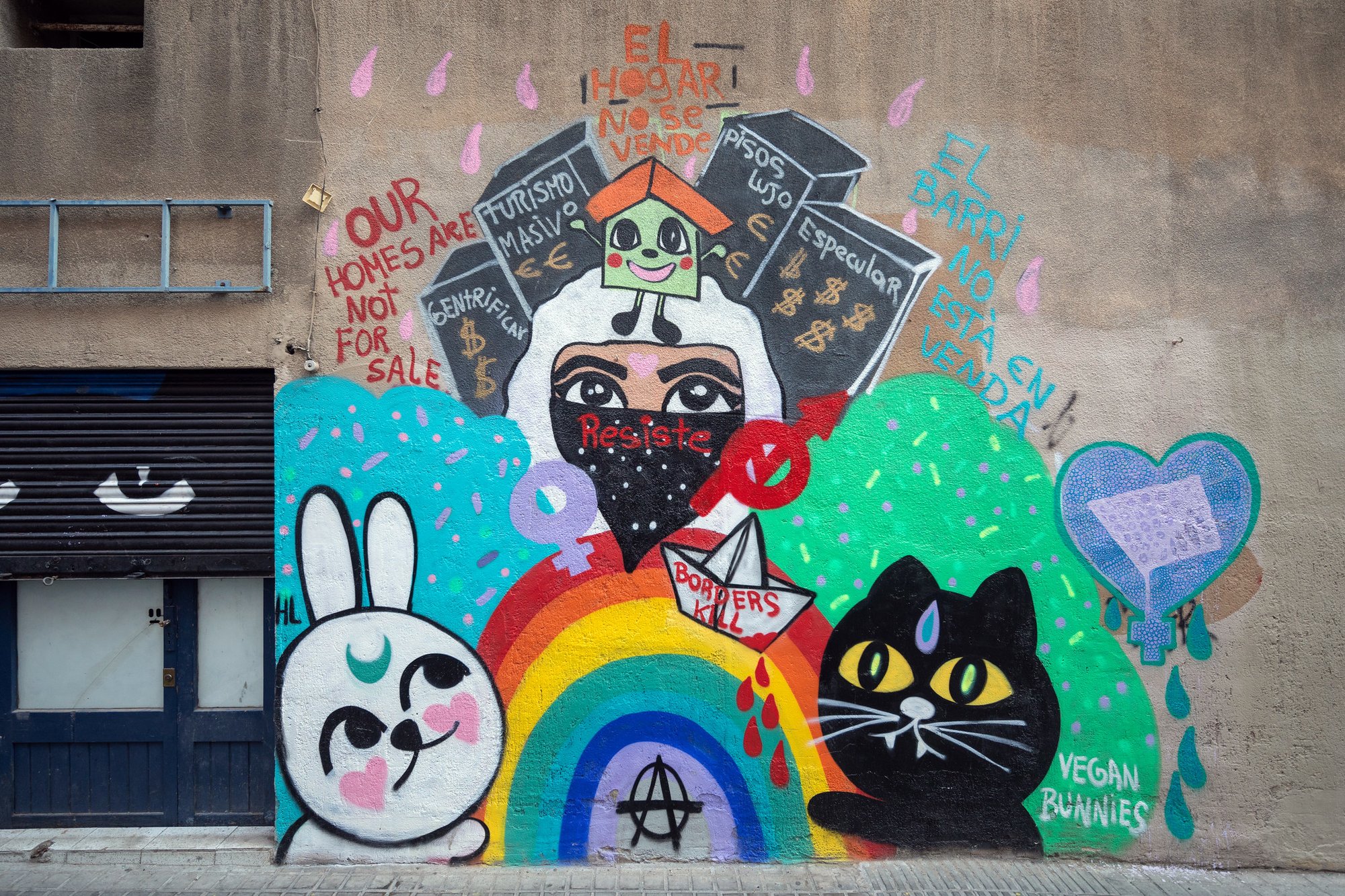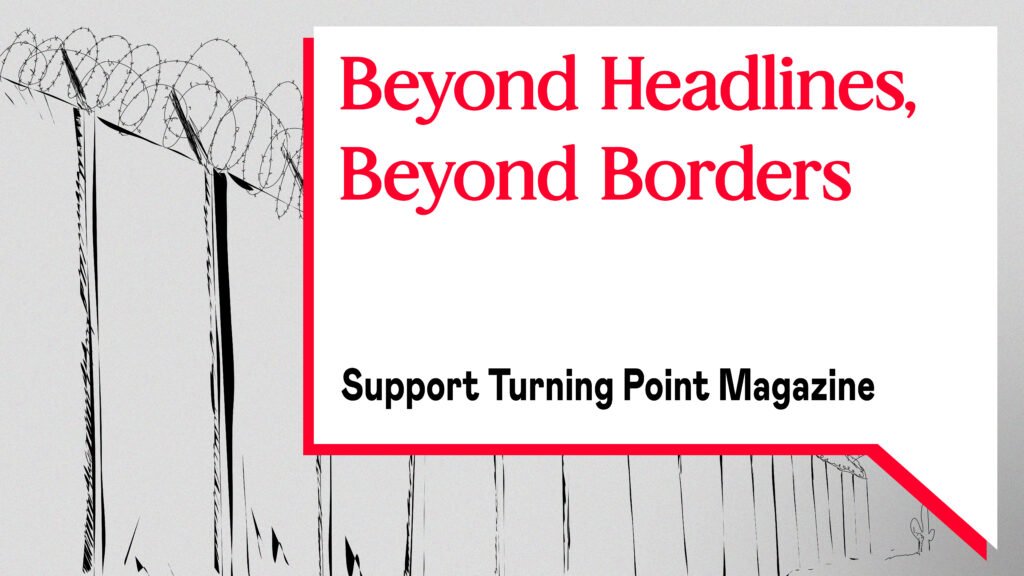Cover photo: Street art in the Gràcia neighborhood by the Spanish-Peruvian artist Vegan Bunnies confronts displacement and the commercialization of Barcelona through gentrification, large-scale tourism, luxury apartments, and real estate speculation, August 2019. ©David Schalliol
On July 6, 2024, like every Saturday, Barcelona’s foremost street, La Rambla, was packed—this time, not only with tourists. Instead, thousands of citizens of the Catalonian capital joined a demonstration against tourism under the rallying cry: “Tourists go home.” The protest images went viral after demonstrators began “shooting” foreigners with water guns.
For years, local associations and institutions have fought against over-tourism to mitigate the cost-of-living impact it generates. This is precisely why, in mid-June, the unprecedented municipality-Generalitat (regional parliament) alliance decided against renewing tourist licenses for short rentals.
“The Catalan parliament has authorized us not to renew licenses for tourist apartments, which will allow us to put 10,000 houses back on the rental or sales market,” said Jaume Collboni, the city’s socialist mayor. The Socialists’ Party of Catalonia (PSC-PSOE) is among the most neo-liberal currents of the Spain-wide PSOE, led by Pedro Sanchez. This latest decision rebuked over a decade of policies. In fact, the PSOE had been in power between 1979 and 2011. The party was keen on reshaping the city for the 1992 Olympics. Entire areas were evicted and demolished to build facilities for the games. As a result, Barcelona became more attractive for tourists and it has developed ever since into one of the favorite foreign destinations in the Mediterranean.
In 2015, Barcelona En Comù, led by Ada Colau, won the municipal elections, marking a major political shift. In its eighty years of government, the party tried to address the housing issue, the rising cost of rents and housing, and the heavy impact of tourist flows on the city’s social dynamics. The housing question was a cornerstone for Colau’s victory, but she never found an understanding with the National and Regional governments. Therefore, Barcelona En Comu could not make significant changes, and the housing question continued to be an issue for the inhabitants fueling frustration and anger aimed at tourists.
Daniel Pardo Rivacoba, an activist from the Assembly of Neighborhoods for the Degrowth of Tourism (ABDT), explained that the July 6 demonstration was organized by 140 associations, though the symbolic actions against tourists were spontaneous and uncoordinated by the organizers.
“Tourists are the most visible part of a serious problem: touristification is a phenomenon that drives more and more inhabitants away from the city and destroys lives,” explained Pardo Rivacoba to Turning Point. Pardo Rivacoba says ABDT does not focus on tourists but on the tourism industry which focuses on profit, and against the public administration which should guarantee citizens’ well-being.
“In any case, if there is one thing this action has proven, it is its effectiveness. It has helped our message to spread, literally, all over the world,” he continued. “For several weeks now, we have been giving interviews to media from all continents.”
According to the ABDT manifesto, signed by all the constituents that make up the network, Barcelona receives about 31 million visitors each year, almost 20 times the number of residents (1.6 million people). The document further explains that “half of the visitors are tourists who spend on average 2.9 nights in the city, while the other half of the visitors stay just one night. We are talking about more than 160,000 daily visits, making it one of the most tourist-saturated cities on a global scale.”
The various associations do not stop with the problem of tourism. They are pushing for a comprehensive rethinking of the city, highlighting how touristification has tremendous consequences for residents, primarily on the cost of living and housing prices, making it almost impossible for locals to live in the city.
“Young people in Barcelona would have to spend an average of 119.7 percent of their salaries to rent a house at market prices.” The Manifesto continues, “in many neighborhoods, traditional premises have been replaced by tourism-oriented commercial premises, and houses have been replaced by tourist and seasonal rental housing. This has led to the expulsion from the neighborhood of the people who originally lived there.”

Last year, I lived several months in Barcelona and I was confronted with the local housing market and its critical issues. Famously, the Spanish writer Manuel Vasquez Montalban said: “In Barcelona, you don’t choose the house. It is the house that chooses you.” When friends and acquaintances repeated this to me, I did not understand it until I started browsing local agencies and online advertisements.
When I first tried to rent a house I was called by the agency at 10 AM for an appointment at 1 PM. After the visit, the broker said: “If you are interested in the house, you have to tell us today and pay the deposit by tomorrow.” I didn’t take it seriously. Two days later I called to say I was interested, and the answer was simply: “You are too late.”
Only after several months, I managed to secure a small apartment in the Raval neighborhood. Its monthly costs were 1100 euros for rent and 100 euros for expenses, as well as an additional 200 euros for an “agency fee.” Being a freelance journalist, I was asked to pay not only the two-month deposit but also the full four months’ rent and expenses as I had no contracts to give as a guarantee.
My experience is not much different from the many other stories I heard during months of research on the topic. Friends have also shared similar accounts. Not to mention the tales—often laden with anger and frustration at us foreigners—of those who were born and raised in Barcelona. Though it was not always like this, whoever arrived in the early 2000s remembers a different situation.
Horacio Espinosa, a university researcher and a member of the Observatory of the Anthropology of Urban Conflict (OACU) explains that, in Barcelona, rents have increased by 43% in the last decade.
“Even if we fall behind the 96% increase in Palma de Mallorca—the most alarming figure in Spain—it is still a dramatic increase,” Espinosa said in an interview. “On average, we Barcelonians spend 58% of our salary on rent, when it would be ‘appropriate’ to spend less than a third, no more than half.”
According to Espinosa, “a parasitic rentier class has been squeezing us for a long time.”
In March 2024, the Barcelona Chamber of Urban Property announced that the average rent in the city is 1,136.40 euros per month. Only 12% of the houses available on the market can be found for less than 1,200 euros per month. The growth of rent cost, according to the chamber, is mainly explained by a “strong imbalance between a growing demand and a supply that cannot keep up.”
In the city, the average monthly salary is 1,516.73 euros, according to the consulting firm Daleph y Ksnet. This is precisely why Enric Barcena, from Barcelona En Comù, argues that the relationship between tourism and living is defined by several factors.
“The first is certainly the transformation of the use of houses, public space, and commercial activities. Then the second element is that touristification—along with large cultural and aggregative events—is used to put real estate pressure on prices,” said Barcena. Fewer houses are on the market for long rentals and prices are increasing, “following” the costs of tourism.
“Certainly there are big studies on the transformation of the use of spaces in the city. During the Covid pandemic, we saw evidence that spaces like La Rambla or Plaza Real emptied and children came back to play there, only to be expelled again with the return of tourism,” continued Barcena.
“There are studies also on the housing issue and how, for example, when tourists are in a resident building there are often conflicts with residents. Tourists have parties, live at night, and make a lot of noise after dark. Locals who wake up early for work are exasperated. These studies also tell us that there are areas where for four beds for tourists there is only one for inhabitants.”

Too often, people who have a property or buy a new house then rent it out on platforms such as Airbnb. This dynamic has led to a constant rise in prices which certainly leads to disadvantages for residents. For Horacio Espinosa “home renters have found an even juicier victim: the tourist. Why slowly squeeze a local when we can take advantage of the flesh and blood of tourists eager to spend a week in the jewel of the Mediterranean? The more the streets fill with tourists, the more the homes of locals empty out. The emptying of local culture, community life, and social support networks is matched by the filling of souvenir stores, coffee shops, and designer cocktail bars. We all know that the tourist is behind these transformations.”
Espinosa continued: “Make no mistake, even tourists are sacrificed on the altar of capitalism. The perpetrators are always the same: the local bourgeoisie, who have decided never to work and live off property instead. Either they rent it to us, the resigned inhabitants of this sewer called Barcelona, or sell it to a vulture fund, or rent it seasonally, enriching other, even worse vultures, such as the owners of so-called ‘collaborative economy’ apps like Airbnb,” sighed Espinosa.
This is precisely why the Tenants’ Unions welcome with joy the limitation of tourist benefits in the city, but also with criticism. They, too, argue that it is not a decisive measure, however important it may be. Without a vision for the city that aims to ensure not only greater availability but also a decrease in prices and individual interests, the city will remain difficult to inhabit—except for those with abundant finances.

Andrea Cegna
Journalist born in 1982. Currently a contributor to several Italian newspapers including Il Manifesto, Radio Onda d’Urto, Radio Popolare, Altreconomia, Il Fatto Quotidiano, Desinformemonos. Cegna started by conducting programs at Radio Lupo Solitario, in the province of Varese. He has also written books, the latest “What Happens in the City” for Prospero Editore. He also makes podcasts and documentaries. He tries to look at the world critically, trying to free himself from the colonialist forms with which we are used, in the West.




